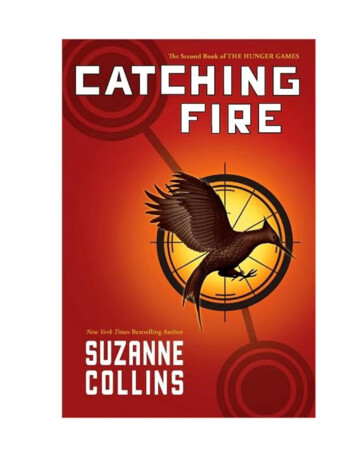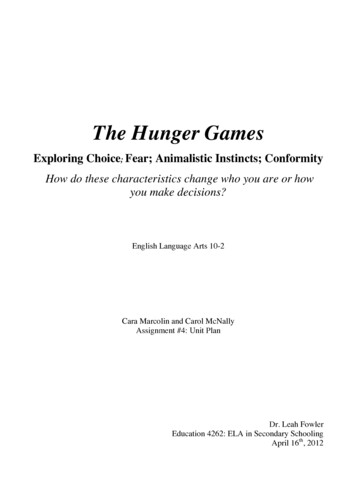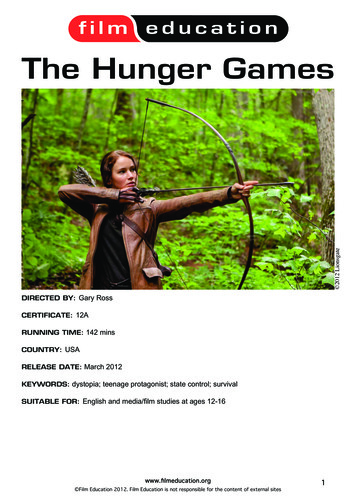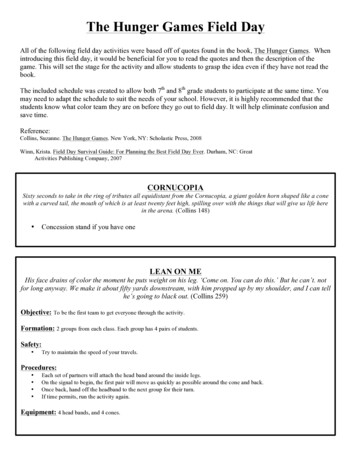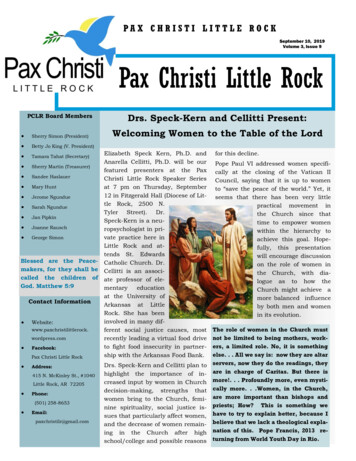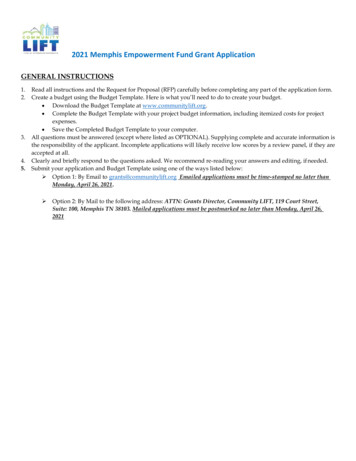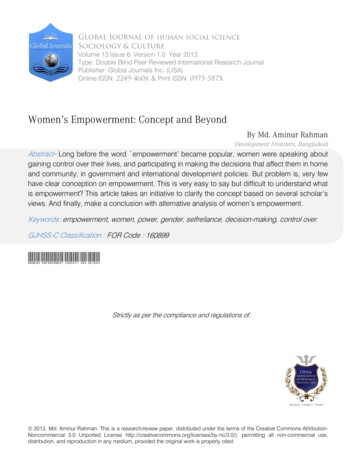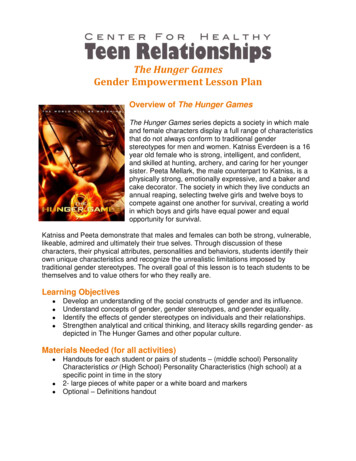
Transcription
The Hunger GamesGender Empowerment Lesson PlanOverview of The Hunger GamesThe Hunger Games series depicts a society in which maleand female characters display a full range of characteristicsthat do not always conform to traditional genderstereotypes for men and women. Katniss Everdeen is a 16year old female who is strong, intelligent, and confident,and skilled at hunting, archery, and caring for her youngersister. Peeta Mellark, the male counterpart to Katniss, is aphysically strong, emotionally expressive, and a baker andcake decorator. The society in which they live conducts anannual reaping, selecting twelve girls and twelve boys tocompete against one another for survival, creating a worldin which boys and girls have equal power and equalopportunity for survival.Katniss and Peeta demonstrate that males and females can both be strong, vulnerable,likeable, admired and ultimately their true selves. Through discussion of thesecharacters, their physical attributes, personalities and behaviors, students identify theirown unique characteristics and recognize the unrealistic limitations imposed bytraditional gender stereotypes. The overall goal of this lesson is to teach students to bethemselves and to value others for who they really are.Learning Objectives Develop an understanding of the social constructs of gender and its influence.Understand concepts of gender, gender stereotypes, and gender equality.Identify the effects of gender stereotypes on individuals and their relationships.Strengthen analytical and critical thinking, and literacy skills regarding gender- asdepicted in The Hunger Games and other popular culture.Materials Needed (for all activities) Handouts for each student or pairs of students – (middle school) PersonalityCharacteristics or (High School) Personality Characteristics (high school) at aspecific point in time in the story2- large pieces of white paper or a white board and markersOptional – Definitions handout
Gender Empowerment 2Estimated Time45 - 50 minutes to complete the following activities: Activity #1- Personality Characteristics (separate handouts for middle and highschools), and Activity #2- Character QuotesOptional Activity #3- Writing Activity as a supplement to Activities #1 and #2.Definitions (for Instructor Use)Gender refers to the social attributes and opportunities associated with being male andfemale and the relationships between women and men, as well as the relationshipsbetween women and those between men. These attributes, opportunities andrelationships are socially constructed and are learned through socialization processes.They are context/ time-specific and changeable.Gender stereotypes are generalized and/or assembled conceptualizations aboutpeople based on gender. Stereotypes depict simplified and rigid view of others and arecentered on a limited number of characteristics. Stereotypes create an impression thateveryone in the group has the same characteristics. Stereotypes create expectations ofwhat males and females should look like and how they should think, feel, and act.Gender equality means that girls and boys, women and men have equal conditions forrealizing their full human rights and for contributing to, and benefiting from, economic,social, cultural and political development. Gender equality is the equal valuing bysociety of the similarities and the differences of each other.Activity #1– Personality CharacteristicsUsing commonly recognized characters from The Hunger Games, students will be ableto identify actual characteristics of male and female characters in the story, understandhow these comply or do not comply with traditional gender stereotypes and discuss thepersonal and societal value of gender equality. NOTE: The overall goal of this activityis to educate students about gender equality, and to help them conceptualize healthygender roles within their own relationships.InstructionsGive each student a Hunger Games Characteristic Sheet (not mentioned in materialssection above. For middle schools, give each student a Personality CharacteristicsHandout. For high schools, give each student a Personality Characteristics, Behaviors,and Activities Handout. Have students work in pairs or small groups. To begin, ask eachgroup to select examples from the handout for each category: personalitycharacteristics, behaviors, and activities. Each character can have similar qualities andthe words can be used more than once.After students have completed The Hunger Games Character Sheet, introduce the ideathat gender is socially constructed. [Tip: post pre-printed term definition sheet forGender for student reference.] Explain that books, movies, music and videos influenceour understanding of gender - how to look, act, dress, and relate to others can be asource that contributes to this composition.
Gender Empowerment 3Class Discussion Questions - Gender and Gender Stereotypes Ask students to share the characteristics, behaviors, or activities theyassigned to Katniss and Peeta. Ask students to differentiate between stereotypical characteristics andcharacteristics that do not conform to traditional gender stereotypes (i.e.Katniss “acting” to show the audience that she is in love with Peeta(stereotypical) versus Katniss prowess as a hunter (non-stereotypical). Ask students to look at the many characters in “Hunger Games” and assesswhich are conforming (i.e. Glimmer and Cato) and non-conforming to genderstereotypes (i.e. Katniss and Peeta). HIGH SCHOOL Handout: Ask students how the characteristics, behaviors,and/or activities changed depending on the situation the character was in?Why or why not?Class Discussion Questions - Popular CultureExplain to students how novels and other forms of popular culture can support ahealthier and more holistic notion of masculinity and femininity by illustrating thefull range of personal characteristics among both male and female characters. Ask students how they think authors, artists, and musicians might contributeto the social construction of gender. How does popular culture pressureyoung people to conform to traditional gender stereotypes vs. expressing theirtrue selves? Ask how it would feel if more characters in books or popular culture were freeto display a full range of characteristics, those that fit into traditional genderstereotypes and those that may not? How could books and movies contribute to a more holistic and realistic socialconstruction of gender?”Activity #2 –Character QuotesWrite each of the following quotes at the top of each piece of paper or a whiteboard.Record student’s responses to the questions that follow, under each character’s name:Katniss Everdeen “It was slow-going at first, but I was determined to feedus. I stole eggs from nests, caught fish in nets, sometimes managed toshoot a squirrel or rabbit for stew, and gathered the various plants thatsprung up beneath my feet. Plants are tricky. Many are edible, but onefalse mouthful and you’re dead. I checked and double-checked the plants Iharvested with my father’s pictures. I kept us alive.”Peeta Mellark “We were five. You had a plaid dress and your hair.it wasin two braids instead of one. ’ So that day, in music assembly, theteacher asked who knew the valley song. Your hand shot right up in theair. She put you up on a stool and had you sing it for us. And I swear, everbird outside the windows fell silent. And right when your song ended, Iknew - just like your mother- I was a goner.”
Gender Empowerment 4After reading the quotes aloud from Katniss and Peeta, ask the students the followingquestions to generate discussion.Class Discussion Questions – Students own experience and impact onrelationships What personality traits and behaviors do not conform to gender stereotypes? Does either of these characters remind you of yourself, someone you know? Do you have personal characteristics that conform and characteristics that donot necessarily conform to traditional gender stereotypes? Would you like toshare them with the class?Class Discussion or Break into Small Group Discussion QuestionsYou can give an option for groups to discuss and report back to the class toengage more students or continue as whole class discussion. How does it feel to read about characters who display such a full range ofbehaviors, activities and physical attributes including ones that might beconsidered outside of traditional gender stereotypes?Are these characters appealing? Why or why not?How to do you think characters like Katniss and/or Peeta contribute to orchange our social construction of gender - or the way we think about gender?What is it like to look at male and female roles in a new and expanded way?What are some of the ways that traditional gender stereotypes affectindividuals, relationships, families, and society?What role does gender play in your relationships with friends and datingpartners? How does it affect who you are and who you date?What would change for us as individuals, in our relationships and in oursociety if men and women could be equally strong and equally vulnerable?Closure to LessonKatniss and Peeta are equally strong, but in different ways. In a world where Katniss isskilled, confident, and a rescuer and Peeta is emotionally expressive, caring, andvulnerable – each person is free to be their true selves. Men and women take controlover their own lives. Katniss and Peeta and the other characters pursue their owngoals, live according to their own values, develop self-reliance, and are able to makechoices and influence - both individually and collectively - the decisions that affect theirlives. Being free to express your true self is critical to becoming a healthy individual andachieving a healthy relationship.For more information log on to www.lovewhatsreal.com or contact Center for HealthyTeen Relationships, a program of the Idaho Coalition Against Sexual & DomesticViolence , 208 384-0419, ext. 313 or email brandy@engagingvoices.org.
Gender Empowerment 5Personality Characteristics.List the top six most important personality characteristics, for each ngActiveSensitiveEmotionally 6.6.
Gender Empowerment 6Select the characteristics that best describe Katniss and Peeta at different pointsin the story (Before Reaping, Television Interviews, and During the motionalRisk takerCaregiverFightsProtectorRisk-takerBefore ReapingArcheryCake frostingBread bakingFashion DesignHuntingSellingBuyingReadingPaintingKnot tyingWeight liftingHousehold ChoresMakeup artistCaretaker1.TelevisionInterview1.During the .3.3.4.4.4.5.5.5.6.6.6.
Gender Empowerment 7Optional Extension - Writing ActivityThe Hunger Games characters exemplify people who display a full range ofcharacteristics and as such, do not conform to traditional gender stereotypes. Are thesecharacters compelling because they seem consistent with socialized norms - orbecause they embody a radical departure from the norms - within the Hunger Gamessociety? I.e., a society dedicated to death-match competition for resources?Write a character portrait the demonstrates a full range of characteristics! Have thestudents respond to the following questions. Start with the basics: What is your character’s name? How old is the character? Is this person a boy or a girl? Where does your character live? What is your character’s family situation?Think about your character’s personality for the following questions: What is your character like? What do they do on the weekend? What is your character proud of? What makes your character feel embarrassed? Two things your character wants. Two things your character fears. One secret your character has.Encourage students to be specific. Then, after the characters are created, ask thestudents what kind of story they’d like to read about this person. Have volunteers sharetheir character portraits.Lesson plan developed by Idaho Coalition Against Sexual & Domestic Violence Center for Healthy TeenRelationships and Start Strong Idaho Team, Expect Respect Team Safe Place Austin, Texas; PattiBellan, MA, Malia Collins, MFA, and Josie Fretwell, MA April 2012 This project was supported by Grant No. 2011-TA-AX-K055 awarded by the Office of Violence Against Women, U.S. Department of Justice. The opinions, findings, conclusions, and recommendations expressedin this publication/program/exhibition are those of the author(s) and do not necessarily reflect the views of the Department of Justice, Office on Violence Against Women.
Gender Empowerment 8DefinitionsGender refers to the social attributes andopportunities associated with being male andfemale and the relationships between womenand men, as well as the relationships betweenwomen and those between men. Theseattributes, opportunities and relationships aresocially constructed and are learned throughsocialization processes. They are context/ timespecific and changeable.Gender stereotypes are generalized and/orassembled conceptualizations about peoplebased on gender. Stereotypes depict simplifiedand rigid view of others and are centered on alimited number of characteristics. Stereotypescreate impression everyone in the group has the same characteristics. Stereotypescreate expectations of what males and females should look like and how they shouldthink, feel, and act.Gender equality means that girls and boys, women and men have equal conditions forrealizing their full human rights and for contributing to, and benefiting from, economic,social, cultural and political development. Gender equality is the equal valuing bysociety of the similarities and the differences of each other.
Center for Healthy Teen RelationshipsCommunity Education Reporting FormPlease return form after each event toM i c a e l a @ e n g a g i ng vo i c e s . o r g ,o r f a x t o 208-331-0687Presenter: Agency:Address:Phone:Email:1. Total number of education events provided (minimum 10 person/event2. Date of Presentation:3. Name of Organization:4. Address of Presentation:City:5. Did anyone who attended the presentation come from a rural community: Yes No6. Number of people educated (Use the category that is most descriptive of the peopleattending the education event)People educated (actual number/category)Child care providersCommunity advocacy groups (NAPCA, NAACP, NAMI)Community businesses (retail stores, pharmacies)Community groups (service or social groups)Community members (unaffiliated adults)Educators and/or school administratorsElementary school studentsFaith-based groupsMiddle and high school studentsParents or guardiansUniversity or college studentsVictims/survivors (do not count psycho-education groups)Other (specify):7. Topics of education eventsHealthy Friendships (grade)Healthy Relationships (grade)Teen Dating Violence- Teens (6-12 grade)Teen Dating Violence- AdultOther (must be approved under project):8. Materials handed out (estimate quantities)Teen Dating Violence brochureParent handbookStickers ButtonsOtherFor questions on the Idaho Teen Dating Violence Project or this form,contact the Idaho Coalition Against Sexual & Domestic Violence 1-888-293-6118
The Hunger Games Gender Empowerment Lesson Plan Overview of The Hunger Games The Hunger Games series depicts a society in which male and female characters display a full range of characteristics that do not always conform to traditional gende
